Territory: The West of Scotland - tough but hearty
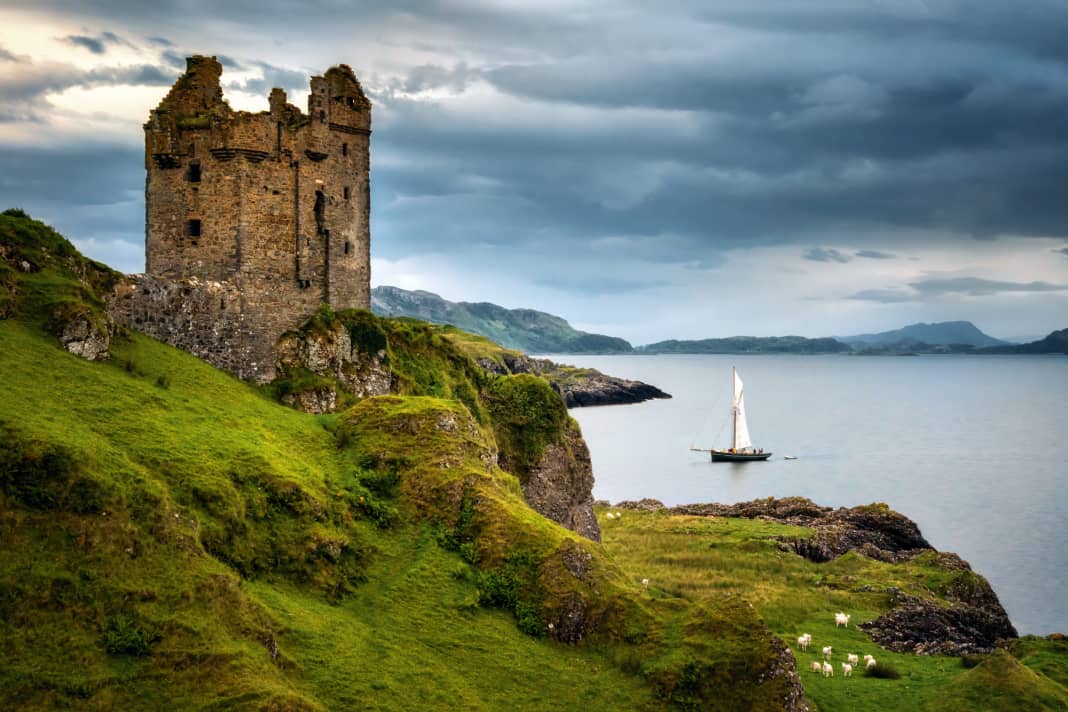





If that doesn't fit! "Farhave I travelled and much have I seen, dark distant mountains with valleys of green, past painted deserts, the sunset's on fire, as he carries me home to the Mull of Kintyre."Paul McCartney's world-famous song, accompanied by the sound of bagpipes, involuntarily comes to mind as the Irish tricolour is hoisted and shortly afterwards the Scottish saltire, the white St Andrew's cross on a blue background, flutters beneath the saling. Together with Frank, a friend, I am travelling from Glenarm, a village north of Belfast, 37 nautical miles across the Irish Sea to Kintyre. The long peninsula shields the Firth of Clyde from the open Atlantic like a bulwark.
First destination in Scotland: Campbeltown
Our first destination in Scotland is Campbeltown. The sailing conditions on the way there could hardly be better - and more atypical for the region. The sun is shining and the wind is blowing from the south-east at 4 Beaufort. That's not much, but it's enough to set my nine-metre long keel "Oblomow", which I'm taking on a long summer cruise around Great Britain with a variety of fellow sailors, into a frenzy on this day at the end of July with half the wind. A marvellous 20 miles. South of Sanda Island we can even drop a few degrees.
On arrival, the harbour master welcomes us on the pier, points to the building opposite and says: "You can pee over there." Frank is confused. He hadn't even asked about the toilets. After asking several times, we understand what the man means: We can pay over there - you can pay over there. Welcome to Scotland; we still have to get used to the dialect.
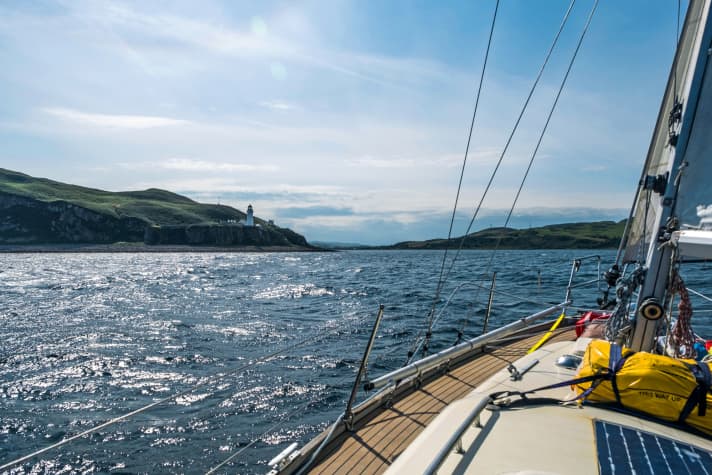
Low pressure over the Highlands
By the evening, there is nothing left of the fine weather. Heavy rain sets in. And it continues. Then fog in the morning, the rain turns to drizzle. Low pressure over the Highlands. Only at midday do we see a slight improvement. The wind has shifted to the west, the blister rises and we are faced with a grey sky that gradually turns blue. We set course for Lamlash Bay between Arran and Holy Island. When we arrive, all the visitor buoys are occupied. Fortunately, the wind has largely died down, so we have no problem finding a safe anchorage. Gannets circle over the bay. All around us, the large birds plunge headfirst into the water with their wings up. We watch the hustle and bustle from on board, mesmerised.
As darkness falls, we watch the lights come on ashore and the high mountains in the centre of the island turn into silhouettes against an inky blue sky. Silence returns as the gannets gradually cease their hunt for fish. Sitting in the cockpit by the light of the paraffin lamp, we savour this special moment.
Just opposite is the small Holy Island. In 1991, the then uninhabited islet was sold to a Tibetan centre. Today, around 30 Buddhists live there in a monastery. And here they are, in Scotland! Fellow sailor Frank turns out to be a big fan of Asia, and my interest is also piqued. We had been told that visitors were welcome in the monastery. As the ferry doesn't run the next day, we move "Oblomow" to an anchorage off Holy Island and take the dinghy across to the rocky beach.
Exploration tour on land
Then we go on an exploratory tour, a little unsettled because there are no people to be seen. In front of the main building, the Centre for World Peace and Health, a few ponies graze peacefully. Prayer flags flutter lazily in the light breeze, otherwise silence reigns. A path leads to the lighthouse in the south of the island. Along the way, in the middle of the heathland, we come across colourfully painted rocks: Buddhist deities. The white Tara, the green Tara - Frank knows them all by name.
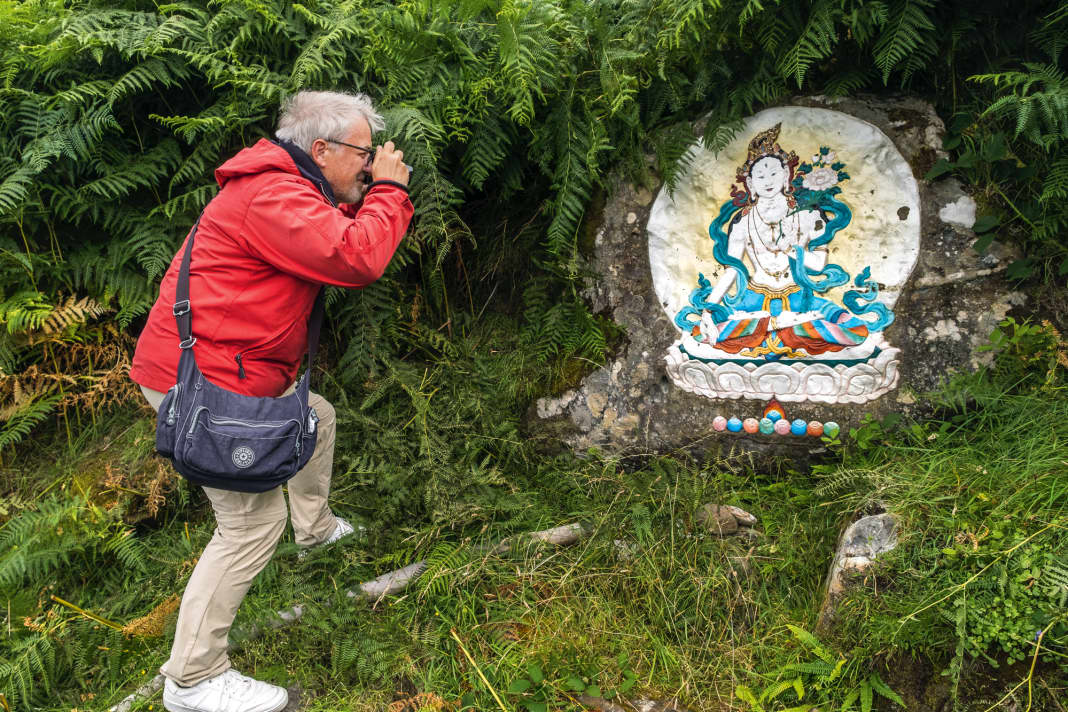


Unfortunately, we miss the turn-off that would have led us back across the island at the top. By the time we realise our mistake, it's already too late to turn back and we have to go all the way round. Dripping wet meadows, jagged boulders, stony shore terrain, there's no end to it. It's also quite exhausting, and more than once we slip dangerously. But finally we have made it, round the last rocky outcrop and are back at the starting point. The prayer flags now glow colourfully in the sunshine.
In the evening, the German women's football team plays against the English women for the European Championship. A second yacht, the "Kailena", has also anchored here in the meantime. We met Bill and Anna, the skipper couple, back in Portaferry, Ireland, and have met up with them a few times since then. Most recently in Bangor, the marina in Belfast. Although they are just as uninterested in football as we are, we sit down together in front of the TV in the lobby of the Glenisle Hotel. As a true Scotsman, Bill is naturally in favour of Germany - albeit in vain in the end!
On a boat hunt with the dinghy
When we step outside the door again, we are in for a nasty surprise. "Kailena" has broken away! We spot her drifting through the bay quite a distance away. At any moment, the yacht threatens to get caught in one of the fish farms out there. Bill and I chase after her in the dinghy and reach her just in time.
Scottish weather is on the cards again the next day, so we abandon the plan to make a shore excursion on Arran. Instead, we make sure that we reach Ardrossan, 13 nautical miles away. A good decision! In the evening, rain starts to fall and strong gusts of wind rattle through the rig. Luckily, we are already sitting in the restaurant in the harbour and try what haggis tastes like. Alongside fish 'n' chips, this is the other Scottish national dish, consisting of a sheep's stomach stuffed with heart, liver, lungs, kidney fat, onions and oatmeal and seasoned with pepper. Not bad, we think. Just don't be put off by the ingredients.
Excursion to Glasgow
We use the day we have saved to take the train to Glasgow. The journey only takes 40 minutes and shortly afterwards we are at the Gallery of Modern Art looking at paintings. The most striking piece of art, however, is in front of the house. The Duke of Wellington is sitting there on his high horse - and on his head, as perky as Johannes Heesters' top hat, is a traffic cone. Sometime in the 1980s, a couple of pranksters had the crazy idea of putting the little hat on the Duke's head - certainly not an entirely safe climb. Of course, the police were quickly on the scene to remove it. But the pylon was soon back on and a lively game of cat and mouse ensued. As this soon became quite expensive because the city had to have a lifting platform brought in each time, which is said to have cost around £10,000 per year, they finally wanted to have the pedestal raised to make it impossible to climb. But the city fathers had reckoned without their inhabitants. A storm of protest broke out. And because even the town's marketing department had now discovered the sheltered duke as an advertising medium, the cone ultimately remained on his head.
Frank's watch ends with the excursion and the next crew change is due. Jörg gets off the night train from London in the morning. A hearty breakfast is enough for him and we set sail at midday. We head over to Arran again, but this time to Loch Ranza, the anchorage in the north of the island. The wind comes from the front, we have to cross, Jörg likes it. He is a tireless helmsman. The 18-mile direct course eventually becomes a relaxed 32 miles and, as a reward, the evening sun shines beautifully and makes the heather on the surrounding mountains glow purple.
After the rain comes the sun
After a hearty shower and having admired the glorious rainbow that the morning sun conjures up diagonally across the water in front of us, it's time for a shore excursion. Straight ahead for a few kilometres down the road, then we find ourselves in front of the Lochranza Distillery. It's still too early for a whisky tasting, but we can reach into the shelves once or twice to complete the on-board bar. They also have a café here, where we get a cappuccino, non-alcoholic.
As essential as it was in the south of England or over in Ireland to be guided by the tide when travelling, it doesn't matter here. In the Firth of Clyde - the English term firth means fjord or inlet - the water levels rise and fall by an average of three metres. But this does not generate any significant surface currents. The same applies to the branching lochs such as Lower Loch Fyne or East Loch Tarbert with the fishing harbour of the same name.
"The setting is picturesque in the extreme, with the village circling the naturally formed harbour", I read on the website visitmyharbour.com who reliably provided me with all the information I needed throughout the trip - garnished with a pinch of English humour. There's no better way to put it.
We cheat our way along the coast for the 14 nautical miles to Tarbert. The sun is shining, our trouser legs are reefed and the wind is doing a brisk three. If only it weren't for the nasty little squalls that keep coming down on us from the mountains.
Back on the Atlantic
We then continue northwards. We reach the Crinan Canal. Seven swing bridges and 15 locks, most of which have to be operated by hand and with full physical effort. All this over a length of just nine nautical miles. The short waterway separates the Kintyre Peninsula from the rest of Scotland and brings us back to the Atlantic. This saves us the long journey back and down around the Mull of Kintyre.
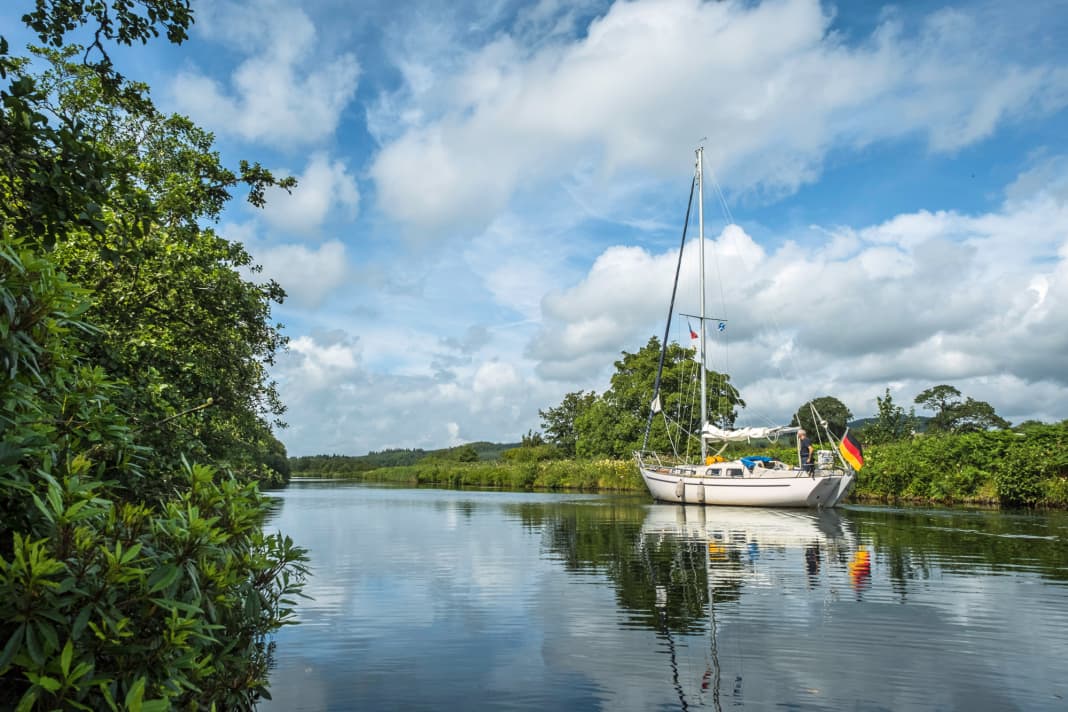


You can easily complete the Crinan Canal in one day, but why should you? Up to four overnight stays are included in the price of the transit. We don't want to take that much time, but I have planned two days. I've been looking forward to the canal ever since I saw a TV report about it at home. The only thing that worries me is the fact mentioned in the film that you have to reckon with massive attacks by midges, tiny but very bloodthirsty mosquitoes that multiply en masse in the fresh water of the canal. In the film, the lock keepers wore hats with a tightly woven veil for protection. We don't have anything like that on board, we would have to improvise.
The fun begins in Ardrishaig. Jörg is on the foredeck, I'm in the cockpit. The mooring lines have to be slung four metres high onto the wall. The sea lock lifts us to the right level. We pay the transit fee, receive a briefing from Tiegan, the cheerful lock keeper, and a key for all the sanitary facilities along the way. The next two locks follow shortly afterwards. Tiegan walks alongside us on the bank until we reach them, then she walks back. We are on our own.
"Liquid Sunshine" in Scotland
Sometimes the journey takes us through dense forest, sometimes along metre-high rhododendron walls, sometimes the view sweeps across wide meadows to the hills on the horizon - Scotland like something out of an advertising film. Only occasionally do we come across another boat. We complete half the route on the first day and spend the night at the jetty in Cairnbaan. For the second half to Crinan, the weather is once again typical of the country: low-hanging clouds and high humidity. Liquid sunshine, as the Scots say. At least it's obviously not flying weather for insects. The dreaded attack by the bloodsuckers doesn't materialise.
When the sea lock in Crinan releases us back into the salt water, we are greeted by thick fog. Instrument flight. But when the cloud cover breaks, the sea begins to glisten. We float as if on crumpled aluminium foil. The high peaks of Jura are still shrouded in mist, but the meadows below glow in lush green as soon as the sun sends a ray through a hole in the clouds. These are moments full of magic! The journey is worth it for that alone.
We find a free mooring buoy in the bay off the village of Craighouse with a view of the Jura Distillery and the hotel. We had made a reservation in the restaurant by phone, and when we enter the bar, Gordon, the bar manager, greets us with a handshake: "Mister Christian, I presume." Dinner tastes delicious. Fish dominates the menu.
After dessert, we engage Gordon in an expert discussion. Of course, he knows all about the fine stuff that is produced right next door. On Jura, as on the neighbouring island of Islay, particularly smoky whisky is distilled. Hefty stuff, unmistakable, but not everyone's cup of tea. The island peat they use here to roast the malt is dark and damp and has a high proportion of seaweed, algae and seawater. Hence the characteristic flavour.
More whisky casks than people on an island in Scotland?
While there are still nine distilleries in operation on Islay, there has only ever been one here. Nevertheless, some people claim that Jura is probably the only island in the world where there are more whisky casks than people.
Next, we let the current wash us northwards through the Sound of Islay. Here the tides play a role again. Despite only a light breeze, we are travelling five knots over the ground. If there is a small push, "Oblomow" even accelerates to nine knots. At the Scalasaig pier on Colonsay, we get hold of the only free berth. Extra-long mooring lines are needed, because the tide rises and falls like a lift.
The next morning we set off on a walk to visit the Colonsay Estate, the house and garden of the 5th Baron Strathcona and Mount Royal. Yes, titles and traditions still count here! Baron Alex lives on the estate with his family, rents out his cottages to paying guests and has a slice of cake and a coffee for us windswept sailing nomads.
When we come back, the "Lake Isle of Innisfree" is just picking up her anchor, where she was waiting for us in the bay, and comes alongside. Eight people and two dogs want to come into our packet. Oh dear. We'd rather swap places. Especially as we want to leave early the next day. Later, they even thank us in the hotel bar: Sláinte, cheers, you're welcome!
Is shortbread from Scotland addictive?
We can only sail for two hours the next day, then we have to use the engine. We take the dolphins in front of and next to us almost as a matter of course. The boring chugging gives us some strange ideas. For example, we discuss the question: is shortbread addictive? This buttery, soft, sweet biscuit from Scotland, which we grab several packs of every time we go shopping because we are sure that we would immediately experience withdrawal symptoms if our supplies were suddenly exhausted.
A magical baking day breeze interrupts our in-depth discussions. It blows the blister and pushes "Oblomow" right up to the North Pier Pontoons. This is the relatively new marina in Oban. This is where Jörg's journey ends and Sanne takes his place. We will continue with her through the Caledonian Canal with its spectacular lock stairs. And of course with a trip across the legendary Loch Ness. Let's hope the monster leaves us in peace.
Tips for the trip
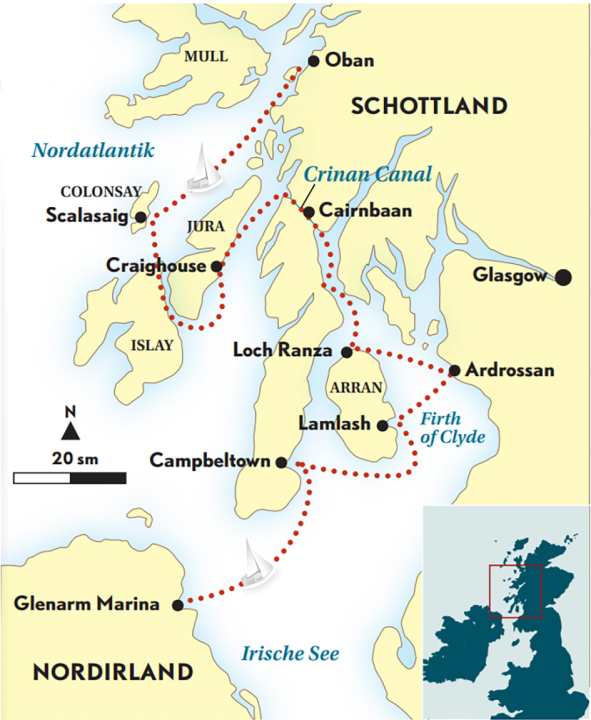
Wind & Weather
The west of Scotland benefits from the Gulf Stream and the climate here tends to be milder than on the North Sea coast. Best time to visit: May to September. On average six hours of sunshine a day in the summer months, but be prepared for changeable weather with rain, drizzle and fog - it's not unusual to experience it all in one day. Contrary to popular belief that the Scottish coasts are mostly stormy, there is often little wind in summer. Equipping yourself with light wind sails is therefore highly recommended.
Navigation & Seamanship
Without significant tidal currents, navigation in the Firth of Clyde is not a major challenge. However, the changing water depths should be taken into account. In contrast, in the Inner Hebrides area, i.e. on the cruise around Jura, Islay and Colonsay described here, you need to pay particular attention to the direction of the current in the hours. Tides and tidal currents are shown by the Navionics boating app, for example. All fairways and harbour entrances are well buoyed and lighted.
Harbours & anchorages
Registration with the harbour master via VHF is usually obligatory. In the high season, you should reserve a berth by telephone one or two days in advance. On visitmyharbour.com In addition to the VHF channels and telephone numbers of the harbour masters, you will also find photos and recommendations for anchorages.
Literature & Charts
- Territory guide: "Reed's Nautical Almanac. For navigation: British Admiralty Chart 2724 and the Imray Charts C 63, C 64, C 65. As travel reading: "The Celtic Ring" by Björn Larsson.
About the author Christian Irrgang
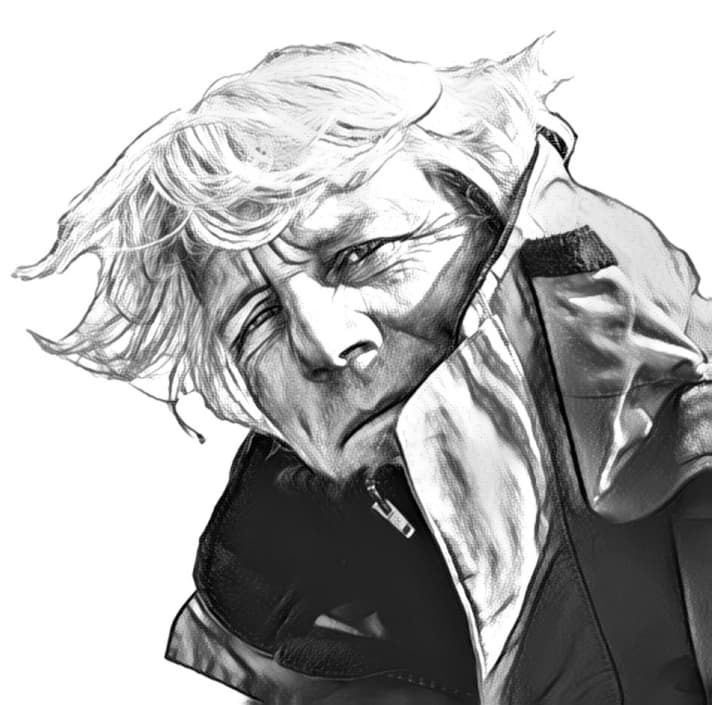
Our author spent five months on a summer cruise around England and Scotland with his boat and various fellow sailors. He has written a book about his experiences (144 pages with 90 photos; 29.90 euros), DELIUS-KLASING.DE

